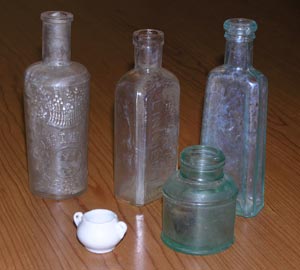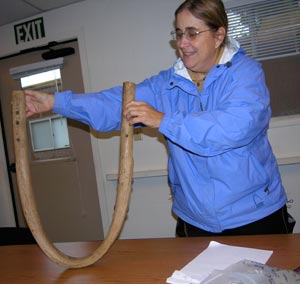A glass perfume bottle and a miniature ceramic sugar bowl from a child's tea set might not seem like impressive archeological finds.
But to UCSC senior environmental planner and archaeologist Sally Morgan, such artifacts unlock a treasure chest of information. They can help fill in some of the blanks in the historical record of life on the 30-acre area just inside the main entrance to the campus that once supported the largest lime manufacturing plant in the state.
"Right off the bat, a perfume bottle and a teacup tell you there were women and children living on the site, which is not something you might have known otherwise," said Morgan. The bottle and sugar bowl likely date to 1900 or a little later, according to Morgan. They were found last fall during digging associated with Ranch View Terrace.
Long understood locally to be an important historical resource, the former lime operations area is now recognized nationally. Dubbed the Cowell Lime Works Historic District, in December the site was added to the National Register of Historic Places, the nation's official list of significant cultural resources worthy of preservation. The historic district includes the Granary, now a childcare center; the Cookhouse, now the Admissions office; several barns; the Cooperage, where barrels for lime shipping were made; the ruins of former workers' cabins; the Blacksmith Shop; the Carriage House; Cardiff House, now the Women's Center but formerly the residence of lime works owner Henry Cowell; and the lime kilns themselves.
"This complex is probably among the most complete in California," said Morgan. "We have a wide range of historical resources that represent the full range of activities that took place on the site historically, including many standing buildings and structures."
To help people learn about the history of the area and what life was like there in the 19th century, Morgan and others have put together a brochure outlining a walking tour of the district, with a map, information on buildings and remains, and historical photographs. The brochure is adapted from the book Lime Kiln Legacies by UCSC alumnus Frank Perry, Robert W. Piwarzyk, Michael D. Luther, Alverda Orlando, Allan Molho, and Sierra L. Perry.
Before Lime Kiln Legacies, there was no other published, detailed history about the lime kilns at UCSC, according to Perry, who earned a degree in Earth sciences in 1977. The 250-page book is available at the UCSC library.
Lime manufacturing played a vital role in shaping Santa Cruz history, said Perry.
"The university wouldn't be here if it weren't for the lime industry," Perry said.
The walking tour brochure will be available in the next couple of weeks at the parking kiosk at the base of campus, as well as in campus libraries and possibly at various downtown Santa Cruz locations.
Also, Morgan and the brochure-production team will put historic photos and artifacts from the site on display in the Science & Engineering Library in the next few weeks. The artifacts will be exhibited there for the rest of the quarter. Additionally, they are working to establish a UCSC-sponsored community involvement group, the Friends of the Cowell Lime Works District, to educate the public and the student body more about the historic district, do more outreach to the public, and to seek grants and other funding for restoration of the historic buildings.
"Restoration is particularly important because some buildings are in bad shape and are at risk of being lost," said Morgan. "Particularly the Cooperage and the workers' cabins. There were originally at least 10 workers' cabins in the district-now only two remain standing."
The team is working on putting up interpretive signs in front of each historical building. In the interim, they'll work on setting up numbered posts that correspond with the numbers in the brochure.
The firm of Davis and Jordan established a lime works at the site in the early 1850s. Lime was a key component of mortar, plaster, and whitewash, and it was used extensively in the building industries of the time. Later, Henry Cowell acquired the lime works and established more support facilities, including a self-sustaining ranch operation, at the site. The Cowell Ranch operations continued until the university acquired the property around 1960.
Other artifacts found in the area at various times have included tools, horse shoes, an oxen yoke, clothing fasteners, dishware, animal bones, shells, a large, intact pig trough, dishes and bottles believed to date to the 1860s, pieces of a cast-iron Cook House stove, boot soles, and an enameled "Mt. Diablo Cement Agency" sign in excellent condition.
Most of these artifacts aren't valuable in terms of money, said Morgan.
"It's really the information they provide that's of interest," she said. "You can find out so much more about how people lived if you have the archeological material."
To answer questions about what life was like in the past, it is critical to the archaeologist to know the locations in which archaeological artifacts are found, and their physical relationships in the ground and to historic structures and features, she said.
It's important people understand that bottle hunting or other disturbance of archaeological sites is destructive to the historic record, she added.
Any ground-disturbing work done within the new historic district now must be accompanied by the presence of an archeological monitor, said Morgan. But even outside the district, the practice of having a monitor on site is common, she said. If the monitor finds something important, work is stopped or redirected elsewhere on the project while the monitor performs data recovery.
Monitors are generally contractors from local firms such as Pacific Legacy of Santa Cruz. UCSC has no staff archeologists, though there are professors with archeological expertise, said Morgan.
Morgan's hope with the walking tour, exhibit, and Friends group is to develop grassroots support for restoration of some of the historic buildings. Once they're functional buildings, she thinks there could be the potential of campus money to maintain them.
"I'd love to see that happen," said Morgan. "The site is so complex and so evocative of 19th century history on the campus."
And that history has never come fully to light, she said.
"The importance of the site is not well known and hasn't been publicized well," Morgan said, despite long-term interest and efforts by local historians such as Perry and many other community members. "I think the historic district is a resource for students and the community that's very much underused and undervalued."
For information about the Friends of the Cowell Lime Works Historic District, email Morgan.




